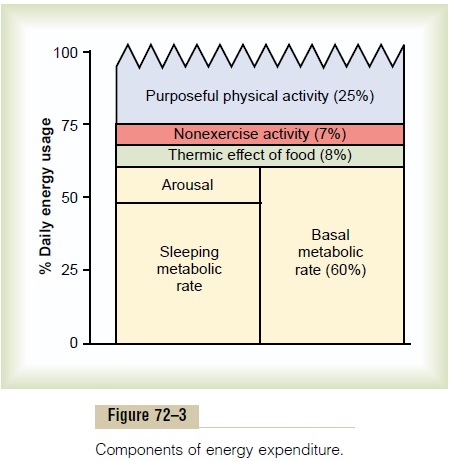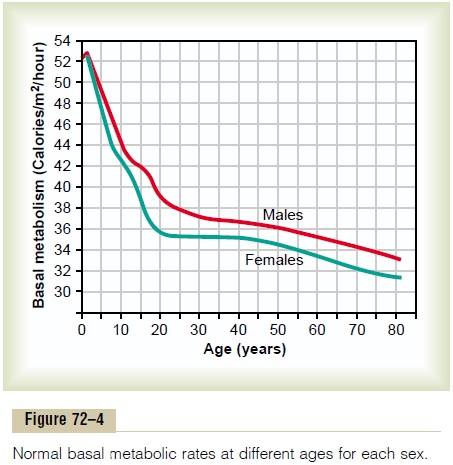Chapter: Medical Physiology: Energetics and Metabolic Rate
Basal Metabolic Rate (BMR)- The Minimum Energy Expenditure for the Body to Exist
Basal Metabolic Rate (BMR)- The Minimum Energy Expenditure for the Body to Exist
Even when a person is at complete rest, considerable energy is required to perform all the chemical reactions of the body. This minimum level of energy required to exist is called the basal metabolic rate (BMR) and accounts for about 50 to 70 per cent of the daily energy expenditure in most sedentary individuals (Figure 72–3).

Because the level of physical activity is highly vari-able among different individuals, measurement of the BMR provides a useful means of comparing one person’s metabolic rate with that of another. The usual method for determining BMR is to measure the rate of oxygen utilization over a given period of time under the following conditions:
1. The person must not have eaten food for at least 12 hours.
2. The BMR is determined after a night of restful sleep.
3. No strenuous activity is performed for at least 1 hour before the test.
4. All psychic and physical factors that cause excitement must be eliminated.
5. The temperature of the air must be comfortable and between 68° and 80°F.
6. No physical activity is permitted during the test.
The BMR normally averages about 65 to 70 Calories per hour in an average 70-kilogram man. Although much of the BMR is accounted for by essential activi-ties of the central nervous system, heart, kidneys, and other organs, the variations in BMR among different individuals are related mainly to differences in the amount of skeletal muscle and body size.
Skeletal muscle, even under resting conditions, accounts for 20 to 30 per cent of the BMR. For this reason, BMR is usually corrected for differences in body size by expressing it as Calories per hour per square meter of body surface area, calculated from height and weight. The average values for males and females of different ages are shown in Figure 72–4.

Much of the decline in BMR with increasing age is probably related to loss of muscle mass and replace-ment of muscle with adipose tissue, which has a lower rate of metabolism. Likewise, slightly lower BMRs in women, compared with men, are due partly to their lower percentage of muscle mass and higher percentage of adipose tissue. However, there are other factors that can influence the BMR, as discussed next.
Thyroid Hormone Increases Metabolic Rate. When the thyroidgland secretes maximal amounts of thyroxine, the meta-bolic rate sometimes rises 50 to 100 per cent above normal. Conversely, total loss of thyroid secretion decreases the metabolic rate to 40 to 60 per cent of normal. Thyroxine increases the rates of the chemical reactions of many cells in the body and therefore increases metabolic rate. Adapta-tion of the thyroid gland—with increased secretion in cold climates and decreased secretion in hot climates— contributes to the differences in BMRs among people living in different geographical zones; for example, people living in arctic regions have BMRs 10 to 20 per cent higher than those of persons living in tropical regions.
Male Sex Hormone Increases Metabolic Rate. The male sexhormone testosterone can increase the metabolic rate about 10 to 15 per cent. The female sex hormones may increase the BMR a small amount, but usually not enough to be significant. Much of this effect of the male sex hormone is related to its anabolic effect to increase skeletal muscle mass.
Growth Hormone Increases Metabolic Rate. Growth hormonecan increase the metabolic rate 15 to 20 per cent as a result of direct stimulation of cellular metabolism.
Fever Increases Metabolic Rate. Fever, regardless of itscause, increases the chemical reactions of the body by an average of about 120 per cent for every 10°C rise in temperature.
Sleep Decreases Metabolic Rate. The metabolic ratedecreases 10 to 15 per cent below normal during sleep. This fall is due to two principal factors: (1) decreased tone of the skeletal musculature during sleep and (2) decreased activity of the central nervous system.
Malnutrition Decreases Metabolic Rate. Prolonged malnutri-tion can decrease the metabolic rate 20 to 30 per cent, presumably due to the paucity of food substances in the cells. In the final stages of many disease conditions, the inanition that accompanies the disease causes a marked decrease in metabolic rate, to the extent that the body temperature may fall several degrees shortly before death.
Related Topics